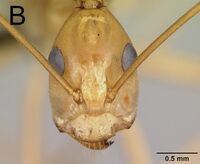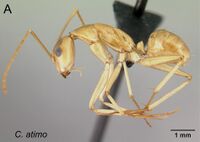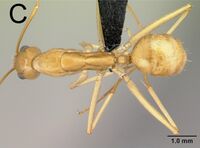Camponotus atimo
| Camponotus atimo | |
|---|---|

| |
| Scientific classification | |
| Kingdom: | Animalia |
| Phylum: | Arthropoda |
| Class: | Insecta |
| Order: | Hymenoptera |
| Family: | Formicidae |
| Subfamily: | Formicinae |
| Tribe: | Camponotini |
| Genus: | Camponotus |
| Subgenus: | Myrmosaga |
| Species: | C. atimo |
| Binomial name | |
| Camponotus atimo Rakotonirina & Fisher, 2022 | |
Camponotus atimo, endemic to Madagascar, generally occurs in the southern part of the island. Its habitats range from dry forest and coastal scrub on limestone of the southwestern region to the transitional forest in the extreme southeastern region and Uapaca woodland in the south-central region through the spiny forest and thicket in the extreme south of the island. Field work during the past 25 years has found this species foraging mostly on the ground and through leaf litter, and very rarely on lower vegetation. It usually nests under stones, in rotten logs and soil layers, and rarely in tree stumps.
Identification
Rakotonirina and Fisher (2022) - With head in full-face view, lateral margins of head anterior to eye level parallel, lacking erect hairs; in oblique profile, four or more pairs of erect hairs arranged successively from level of anterior ocular margin towards posterior cephalic margin; clypeus with distinct anterolateral corner; in profile, junction of propodeal dorsum to declivity rounded; petiole nodelike and not anteroposteriorly compressed.
Camponotus atimo may be difficult to distinguish from Camponotus tapia in that both species have the same body shape and the dorsum of the head is fringed with four or more pairs of erect hairs arranged successively from the level of the anterior ocular margin towards the posterior cephalic margin. However, in C. tapia, the junction of the propodeal dorsum to declivity surface is angulate.
Camponotus atimo also may be confounded with Camponotus strangulatus, but the latter is characterized by the head having only three pairs of erect hairs arranged successively from the level of anterior ocular margin towards the posterior cephalic margin.
Keys including this Species
Distribution
Distribution based on Regional Taxon Lists
Malagasy Region: Madagascar (type locality).
Distribution based on AntMaps
Distribution based on AntWeb specimens
Check data from AntWeb
Countries Occupied
| Number of countries occupied by this species based on AntWiki Regional Taxon Lists. In general, fewer countries occupied indicates a narrower range, while more countries indicates a more widespread species. |

|
Estimated Abundance
| Relative abundance based on number of AntMaps records per species (this species within the purple bar). Fewer records (to the left) indicates a less abundant/encountered species while more records (to the right) indicates more abundant/encountered species. |

|
Biology
Castes
Nomenclature
The following information is derived from Barry Bolton's Online Catalogue of the Ants of the World.
- atimo. Camponotus atimo Rakotonirina & Fisher, 2022: 46, figs. 24A, 26B, 30A, 43 (s.w.) MADAGASCAR.
- Type-material: holotype minor worker, 1 paratype major worker.
- Type-locality: holotype Madagascar: Toliara, 15.5 km. 236° SW Marovato, -25.55389, 45.25583, 230 m., 14.ii.2002, BLF05595 (B.L. Fisher, C.E. Griswold & Arthropod Team); paratype with same data.
- Type-depository: CASC.
- Distribution: Madagascar.
Unless otherwise noted the text for the remainder of this section is reported from the publication that includes the original description.
Description
Worker
Morphological measurements: see Appendix 1 and Ratios of morphometric data for majors and minors
Minor With head in full-face view, lateral margins anterior to eye level parallel, converging abruptly towards posterior margin behind eye level; eye large and convex (EL/CS: 0.28±0.01; 0.26–0.30), interrupting lateral cephalic border, level of its posterior margin situated approximately at posterior 1/3 of head (PoOc/CL; 0.27±0.01; 0.25–0.29); frontal carinae close to each other, their distance equal to or smaller than their smallest distance to eye (FR/CS: 0.23±0.01; 0.22–0.25); clypeus with anterolateral angle and broadly convex anteromedian margin; mandible with two apical teeth distant from each other; antennal scape relatively long (SL/CS: 1.66±0.09; 1.48–1.84). Promesonotum weakly convex and mesopropodeum feebly convex (MPH/ML: 0.33±0.02; 0.29–0.36), mesonotum flat near weakly visible metanotal groove; propodeal dorsum anteriorly convex, posteriorly flat, rounding to declivity; propodeal dorsum 2 × as long as declivity. Petiole nodiform, its dorsal margin inclined posteriorly, rounding to anterior margin; anterior face 1/2 height of posterior face; femur of hind leg rounded axially, not twisted near base.
First and second gastral tergites without a pair of white spots; lateral margin of head without erect hairs; posterior cephalic margin with a pair of erect hairs; in profile, four pairs of erect hairs arranged from level of anterior margin of eye to posterior cephalic margin; erect hairs lacking from antennal scape, pubescence present; pronotum with a pair of erect hairs; posterodorsal angle of propodeum without erect hairs.
Major With characteristics of minor worker, except for the typically broader head (CS: 3.23±0.34; 2.80–3.77; CWb/CL: 0.97±0.04; 0.89–1.03), with broadly concave posterior margin; apical 1/3 of antennal scape extending beyond posterior cephalic margin; robust mesosoma, with propodeal dorsum convex immediately posterior to metanotal groove and < 2 × as long as declivity; petiolar node compressed anteroposteriorly.
Type Material
- Holotype worker. MADAGASCAR: Province Toliara: 3.5 km 236° SW Marovato, -25.55389, 45.25583, 230 m, spiny forest/thicket, ex rotten log, 14 Feb 2002 (Fisher, Griswold, and Arthropod Team) collection code: BLF05595, specimen code: CASENT0454042 (CAS).
- Paratype. 1 major worker same data as holotype but specimen coded as: CASENT0454043 (major) (CAS).
Etymology
This new name atimo is a singular non-Latin noun used in apposition, derived from the Malagasy word for “south” in reference to the restricted distribution of the species to the southern half of Madagascar.

